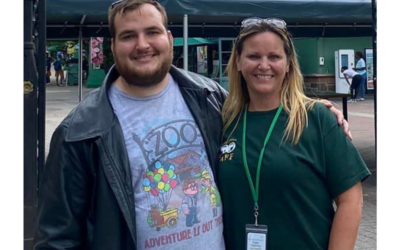“If nothing changes, nothing changes.”
Right now, we have an extraordinary opportunity to influence change in our field. As we write this, prominent zoos in key markets across the country—Chicago, Detroit, Louisville, Milwaukee, Portland, and most recently St. Louis and Columbus—are seeking new leadership. And there will be more to come in other cities across the country in the next year.
This is a transformational time for our profession. This is our opportunity to shape our field to better reflect the country as a whole and the audiences we serve and seek to serve. Diversity, equity, and inclusion need to be more than statements and promises—they must be actions. During this momentous transition of leadership, we need to seize the opportunity to bring different faces into our leadership ranks, welcome diverse perspectives, and seek nonconforming ways of leading for “the new tomorrow.”
If we’ve learned anything during this past crazy year, it’s that our field is resilient, resourceful, supportive, and innovative, with a surprising entrepreneurial streak. We’ve been awakened to, or reminded of, the bigger picture of societal change. We understand and have acknowledged that our missions of saving wildlife must include deeper and more inclusive connections to our communities.
Yet, as a profession and most especially in our leadership ranks, we do not reflect society at large. We do not reflect our communities, and without change, we risk extinction. We now face one of the greatest opportunities—and challenges—in our history. The path to success is clear: a rapid attack on the status quo and a thoughtful and intentional approach to changing the face of our organizations. It’s up to all of us to embrace that change as we seek the leaders of tomorrow.
The face of success is changing, and we need to put aside, or better yet, throw away, our perceptions and stereotypes of what leadership is and what it looks like. We must aggressively identify, recruit, and hire more diverse leaders with different skills and qualities. The same old approaches to leadership transition will not work. Building a more diverse workforce starts at the top—and it needs to start now.
The Data
The white, male-dominated world many of us grew up in is fast disappearing. Places where we live, work, play, learn, and worship look profoundly different than even a generation ago. The U.S. population is changing rapidly: in 1990, when many of our organization’s current leaders were entering the workforce, non-Hispanic whites represented about 75% of the population. Today, that picture has changed dramatically: this group now represents about 60% and by the next generation, they will be a minority. Our Asian, Hispanic, and Black populations have grown over the last decade by double digits, while growth in the white population is just over 4.0%. Minorities will become majorities; diversity, the norm.
In many of the communities with vacant leadership positions, the demographics reinforce the need for change: Chicago‘s MSA (Metropolitan Statistical Area) population is 48% non-white; Louisville’s is 25%; Milwaukee’s, 31%; Detroit’s, 34%; and St. Louis’ is 27%.
When we look at leadership in the U.S. workforce, we see a different, less diverse picture of race, ethnicity, and gender. Gender balance is shifting, although more slowly, and women of color notably lag behind in leadership roles. Since 2015, the percentage of women in C-suite positions has grown from 17% to 21% (McKinsey). When we consider the intersection of race, ethnicity, and gender, the picture is startling—and should be a wake-up call: women of color make up just 3% of C-suite positions, while white men comprise 66% of those positions.
A look at the top leaders of AZA organizations reflects an equally troubling picture. While improvements have been made in gender equity with approximately 26% of institutions led by women, greater progress is needed. When looking at BIPOC representation in the CEO/President/Executive Director role, the numbers are miniscule, and some would say embarrassing. While current numerical data is not available, by our observations there are seven people of color (a number that just grew by one this week) currently leading AZA institutions with some groups not represented at all. When looking at intersectionality, the numbers are stark, with only two women of color at the Director level in a zoo.
This lack of diversity is equally notable in board rooms and around the tables of governing authorities of zoos and aquariums across the country. While progress has been made on this front, most board rooms still lack credible BIPOC representation and don’t reflect the community or the audiences these organizations serve. We’ve seen some encouraging progress in the AZA board of directors: seven out of twelve members are women and three are people of color; our focus must now be on the executive level of member institutions, their boards, and their partner organizations.
The Case for Change
Most of us would agree that broadening our perspectives and pursuing diversity and equity is the right thing to do. Given the tragedies and social upheaval that came to a head last summer and the continued impacts of the coronavirus pandemic, soul searching is in order. These events have forced us to come to terms with our personal and professional ethos. What kind of people are we? What kind of institutions do we lead, do we want to lead? Will we welcome “the new tomorrow” with its growing brown and Black faces? Will we truly embrace people with differing abilities? Will we give women the opportunities they deserve? What kind of leaders will succeed in the future?
Soul searching is not enough. Action is required—urgent action! If we are to remain relevant and sustainable in the communities we seek to serve, changing the face of leadership at the top of our organizations is not only a moral imperative but a business imperative.
Excuses are no longer acceptable. There aren’t enough diverse qualified leaders. We need to fix the pipeline. Diverse leaders don’t see a career path in our field. We need to change our thinking.
The Path to Change
We propose a recalibration of our approach to leadership and to identifying those leaders. It’s no longer about just the business at hand, but about recognizing the need to “feed the culture,” to welcome, accept, and appreciate the whole person. As one zoo director noted, “Having a diverse workforce isn’t the goal. The goal is to save the world. Having a diverse workforce is the only way we’re going to accomplish that.”
Our efforts must be deliberate and intentional. We must actively change how we approach leadership search and transition. The way we look. Where we look. The methods we use to find leaders. We must look beyond the traditional avenues, farther afield, deeper into organizations, to find those leaders who can take our field into the next decades, into a world rapidly changing. We must reexamine our interviewing and hiring practices. We must create leadership transition, support and coaching, programs to ensure leaders of color and women are fully prepared to lead our organizations into an ever-evolving future.
Our path to change must include re-envisioning “the pipeline,” deepening “the pool,” and seeking new leaders in places unfamiliar and uncomfortable for us. We can “be the change we wish to see” if we reject old paradigms and boldly seek new ways of thinking and working.
We can dramatically alter the face of leadership if we get “comfortable being uncomfortable”. DEAI (Diversity, Equity, Accessibility, and Inclusion) shouldn’t be just a committee, it should be a way of thinking and a call to action. This is our time to really live AZA’s ‘5th Promise’. We can start this process today—in Chicago, Detroit, Milwaukee, Portland, Columbus and Saint Louis. It will take bravery, courage, and a demand for change.
Zoo Advisors is a leader in effecting organizational change through its planning, consulting, and advisory services to zoos and aquariums around the globe. We serve as a resource to the community—creating platforms for dialogue, convening critical conversations, and offering solutions to advance missions and realize visions. The ZA team has assisted many organizations in leadership transitions and development and executive search.
Download the full position paper here.
Further References:





